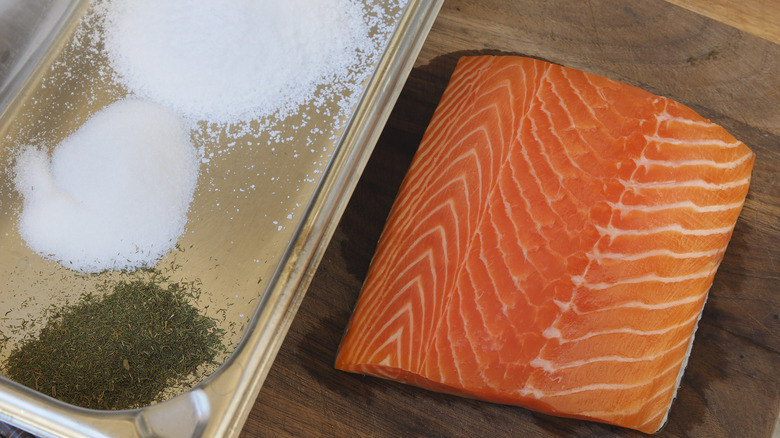The Flavorful Reason Alton Brown Weighs Down Smoked Salmon
Smoked salmon is somewhat of an acquired taste, but those who've acquired it tend to love the delicacy for its unique and intense flavor. Smoked salmon, not to be confused with lox, is a type of preparation that involves smoking the fish with wood to impart more flavor. The filet can either be dry cured, wet cured, or not cured at all, and can be eaten raw or cooked depending on whether it's cold smoked or hot smoked.
Of course, food science aficionado Alton Brown has done this at home (and thinks you should, too). Brown likes to cure the fish first, before the smoking process even takes place. But, after he thoroughly rubs the salmon with seasoning and before he leaves it to cure in the refrigerator for 24 hours before cooking it, Brown adds one more important step: He weighs it down.
Why? Because adding weight and applying pressure to the fish will ultimately enhance its final taste and texture. As Brown explains in an episode of "Good Eats," "compressing the meat will make it take the cure better," and the salmon will "end up with a finer texture."
How to dry cure salmon at home
To be like Alton Brown and try this at home, you'll want to start with a high-quality, large filet of salmon with the skin on and any bones or pins removed. Brown's recipe for a dry rub includes just kosher salt, sugar, brown sugar, and peppercorns, but you can also add more flavor in the form of fresh herbs, garlic, citrus zest, or more of your favorite spices. As a general rule, stick to an equal ratio of salt to sugar — using around 1 cup of each for every pound of salmon — and about a teaspoon of any other added flavoring per pound of fish.
Then comes rubbing, wrapping, and weighing down the fish. First, you should spread out the dry cure gradually on a piece of plastic wrap and place the fish on top, skin side down. Spread more of the seasoning on top, rubbing it generously into the piece of fish. Then wrap up the salmon tightly in the plastic wrap (Brown likes to additionally wrap it in foil) and place the filet between two flat surfaces, like planks or baking sheets, and place it in the fridge. To weigh it down, you can use anything from a phone book to heavy cans or a Dutch oven.
Brown recommends leaving it to sit and cure in the fridge for 24 hours, flipping it halfway through. Once the time is up, then rinse the fish off, pat it dry, and let it completely dry in a cool place for one to three hours.
There are several ways to smoke salmon
Once the fish has been properly cured, it's time to cook. The important thing to remember when you smoke salmon is to make sure the fish is sufficiently dried, and that you've allowed what's called the pellicle to form — this is when the proteins that were brought to the surface in the curing process are dried, which creates a matte-like film that helps the fish smoke successfully.
You can smoke salmon (or other fish — Alton Brown notes that mackerel, bluefish, and trout are all great options as well) using several different methods. The most obvious is to use a smoker, cooking the salmon over wood or sawdust at a low temperature (anywhere from 150 degrees Fahrenheit to 225 degrees Fahrenheit) until the fish reaches an internal temperature of 140-150 degrees Fahrenheit.
If you're wondering how to make smoked salmon without a smoker, you have a few options. You can grill the fish on a barbecue over wood chips or on a cedar plank at a low temperature (like 250 degrees Fahrenheit). You can also create your own smoker device using wood chips, foil, and a cake rack, or steamer basket in a Dutch oven. Or, you can skip it entirely, and use liquid smoke in the curing process to impart the same flavor.



